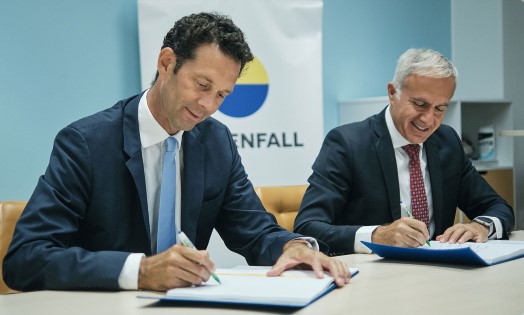Engie Electrabel’s four-unit Doel nuclear plant, in East Flanders, Belgium. Units 1, 2, and 4 are to be closed in 2025; Unit 3 is to be shuttered in 2022. (Photo: Torsade de Pointes)
A pronuclear think tank in Belgium has written a letter to the country’s prime minister, Alexander De Croo, urging him to reevaluate the government’s plan to phase out nuclear power generation by 2025 and replace it with gas power.
A ceremony marking the delivery of Orano’s TN-LC transport cask to Korea Hydro and Nuclear Power Company was held on August 24. (Photo: Orano)
Orano has delivered its first TN-LC spent nuclear fuel transport cask to Korea Hydro and Nuclear Power Company. The first use of the cask is planned for an international transport between South Korea and Sweden by the end of 2021.
KHNP received a license in June for the TN-LC transport cask from the Nuclear Safety and Security Commission, South Korea’s regulatory agency, for the transport of high-burnup spent fuel.
Materials experiments in the Anechoic chamber at NNSS. (Photo: NNSS)
The 11th installment of the ANS Young Members Group Spotlight on National Labs will feature the Nevada National Security Site. The webinar, moderated by ANS YMG member Kelsey Amundson, will be held this Thursday, August 26, noon - 1:30 pm EDT. The event is free and open to all, so please register now.
Diablo Canyon nuclear power plant
With California’s electricity rates the highest in the continental United States, and with rolling blackouts last summer and more blackouts likely this year, now is not the time to shut down the emission-free, reliable energy source that is the Diablo Canyon nuclear power plant, according to Gene Nelson, the legal assistant for Californians for Green Nuclear Power.
The two-unit Diablo Canyon nuclear power plant is scheduled to be shut down in 2025.
Vattenfall’s Christopher Eckerberg (left) and Aziz Dag of Westinghouse Electric Sweden AB sign the agreement for decommissioning of large radioactive components at Sweden’s Ringhals-1 and -2. (Photo: Vattenfall/John Guthed)
Westinghouse will segment and dispose of the reactor internals and pressure vessels at Sweden’s Ringhals-1 and Ringhals-2 under a deal announced last week with plant owner Vattenfall. Unit 2, a pressurized water reactor, and Unit 1, a boiling water reactor, were shut down in 2019 and 2020, respectively, after operating for more than 40 years.
A new facility being built at the Advanced Photon Source will allow research into irradiated materials.
This rendering shows the Activated Materials Laboratory (AML), to be constructed as part of the Advanced Photon Source upgrade that includes the High-Energy X-ray Microscope (HEXM) and the In Situ Nanoprobe (ISN). This new facility will simplify the process of researching nuclear materials.
(Image: Argonne National Laboratory)
The lack of a specialized laboratory at Argonne National Laboratory’s Advanced Photon Source (APS) has slowed efforts to study irradiated materials at the facility. Things will change soon, however, with the addition of the new Activated Materials Laboratory that is planned to be built and operational by 2024.
Nine Mile Point (Photo: Constellation Energy)
Exelon Generation has received a grant from the Department of Energy to explore the potential benefits of on-site hydrogen production and has chosen its Nine Mile Point nuclear power plant as the demonstration site, the company announced on Wednesday. (In 2019, Exelon received a conditional commitment from the DOE to co-fund a hydrogen electrolyzer demonstration at a nuclear plant.) Located in Scriba, N.Y., Nine Mile Point consists of two boiling water reactors—the 620-MWe Unit 1 and the 1,287-MWe Unit 2.
Hanford workers fit sections of double-walled pipe in place, connecting the site’s tank farms to the Waste Treatment and Immobilization Plant. (Screen shot: WRPS/YouTube)
The Department of Energy is celebrating a major milestone in its tank waste mission at the Hanford Site near Richland, Wash. DOE tank operations contractor Washington River Protection Solutions has finished construction of the pipeline that will carry treated waste from an underground tank to the Waste Treatment and Immobilization Plant (WTP) for vitrification.
The EBR-II sodium fast reactor at Idaho National Laboratory began operations in 1964 and generated electricity for decades. Soon it will serve as a National Reactor Innovation Center test bed for future advanced reactor demonstrations. (Source: ANL)
At the box office or streaming at home, it’s fear, not truth, that sells. The laws of physics are swept aside, apocalypse is inevitable, and superpowered heroes wait until the last possible second to save the universe. It can make for great entertainment, but in the real world we need to stick with science over science fiction and be wowed by engineering, not special effects.
The truth is, science and innovation are incredible in their own right. From communications and machine learning to space travel and medical advances, technology is evolving in hyperdrive to solve real problems. With climate change and global warming here on earth, we don’t have to go looking for trouble in a galaxy far, far away.















 and Aziz Dag of Westinghouse Electric Sweden AB.jpg)




 The Canadian Nuclear Safety Commission and the U.S. Nuclear Regulatory Commission have completed the first collaborative project under a two-year-old memorandum of cooperation (MOC) aimed at enhancing technical reviews of advanced reactor and small modular reactor technologies, the CNSC announced earlier this week.
The Canadian Nuclear Safety Commission and the U.S. Nuclear Regulatory Commission have completed the first collaborative project under a two-year-old memorandum of cooperation (MOC) aimed at enhancing technical reviews of advanced reactor and small modular reactor technologies, the CNSC announced earlier this week.